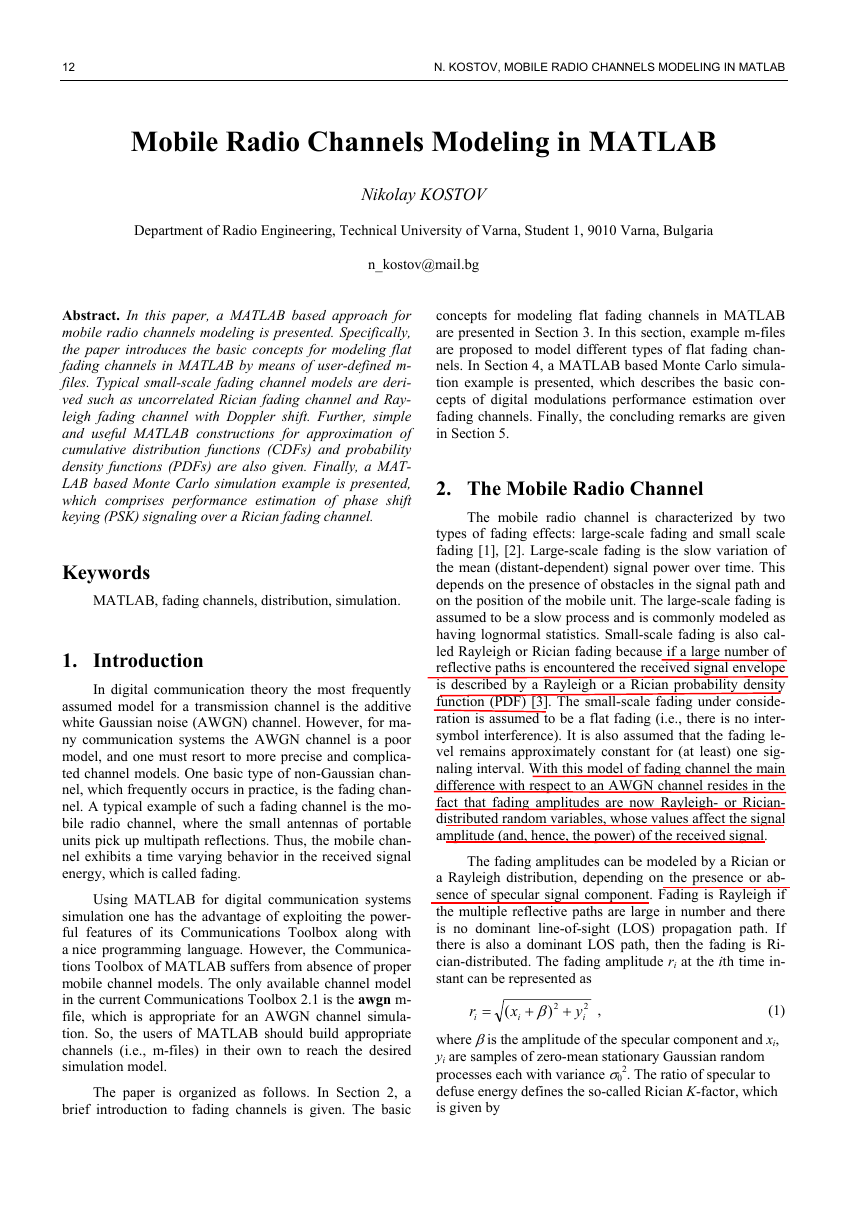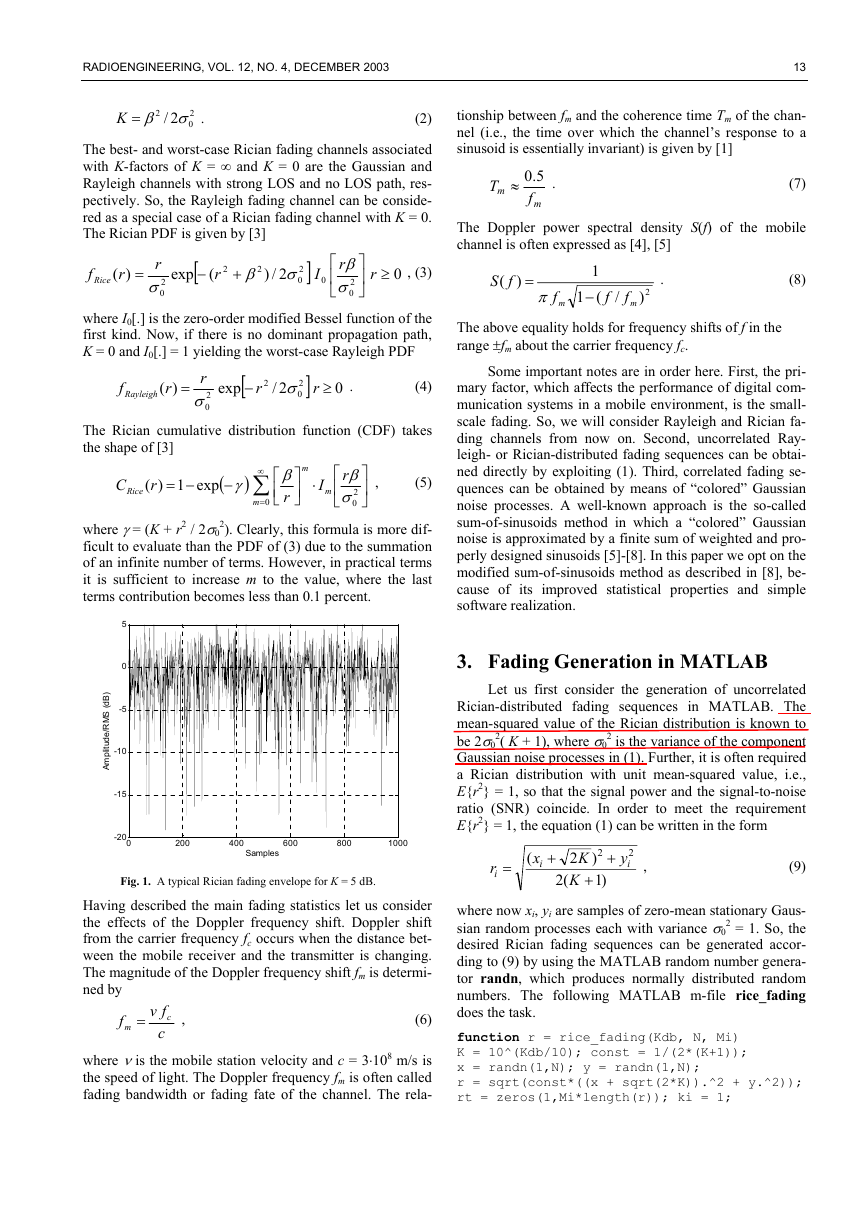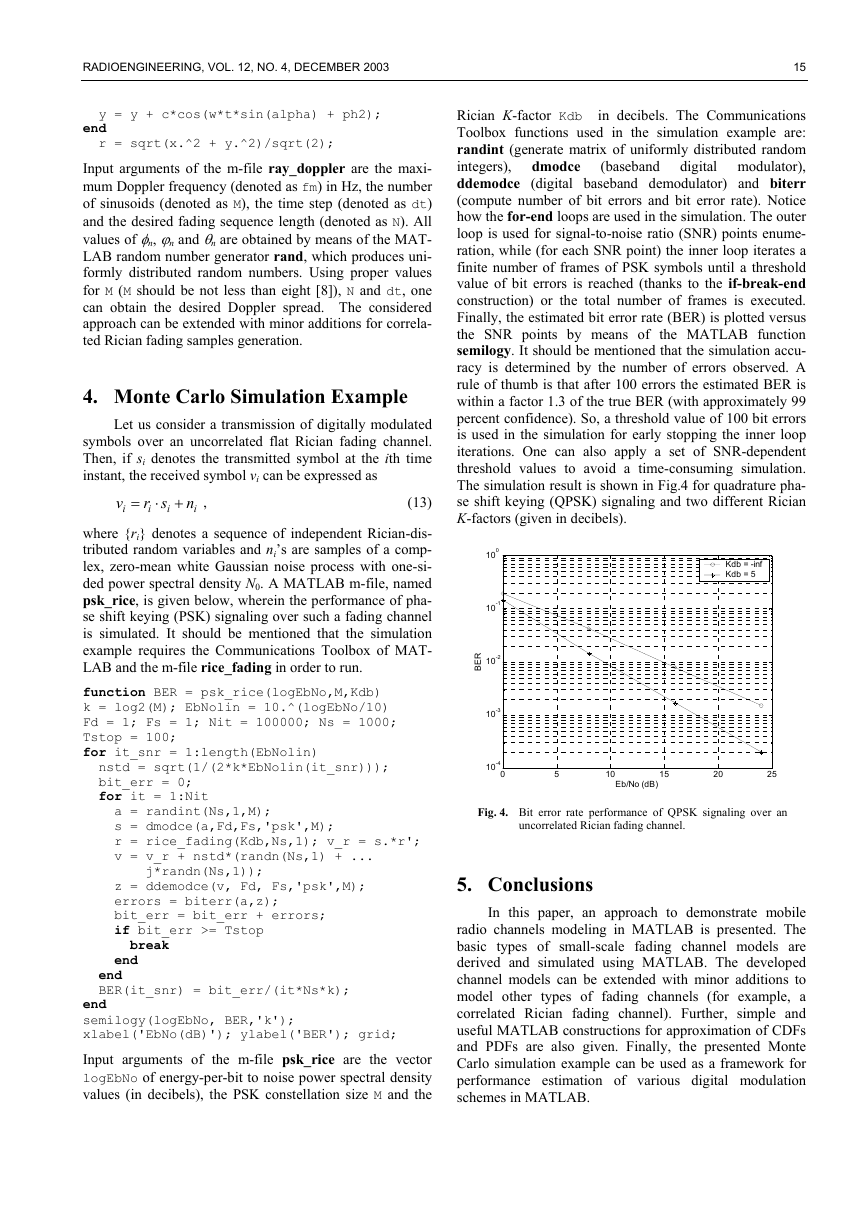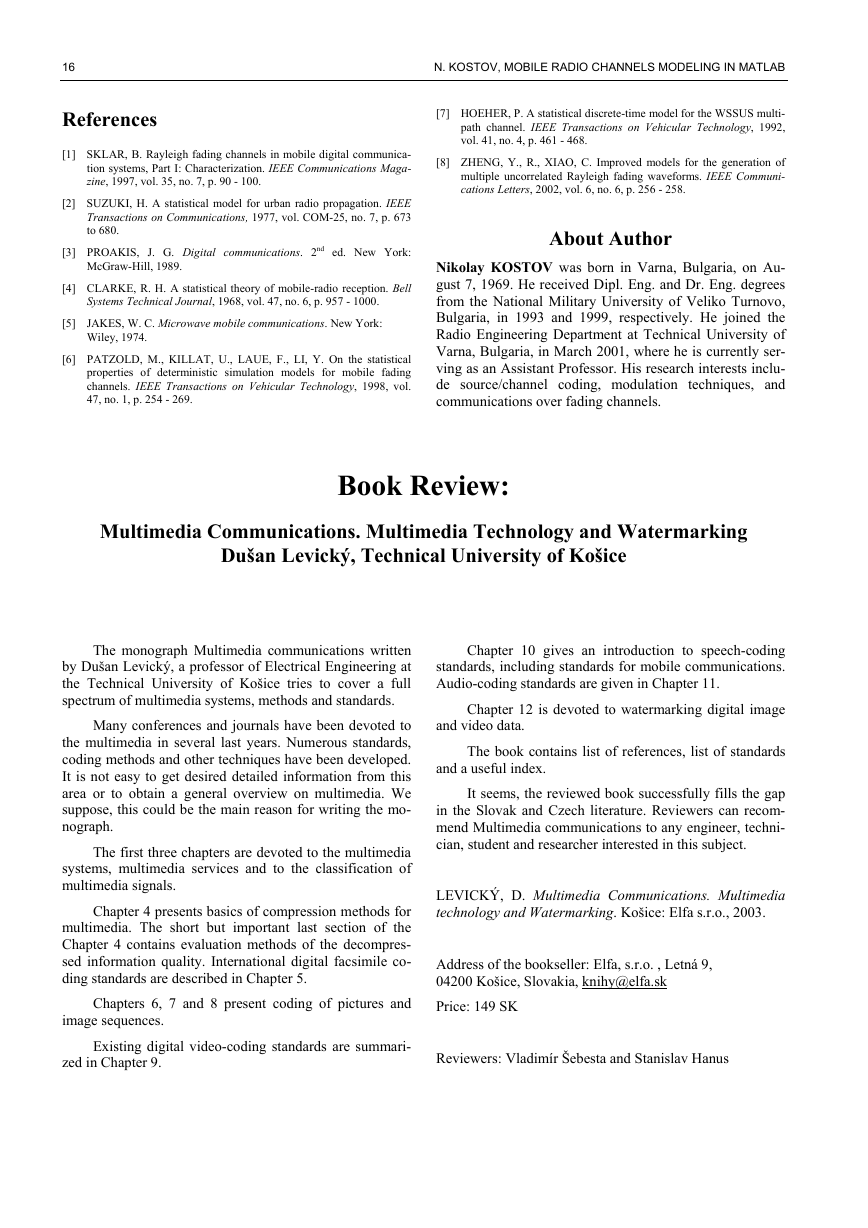12
N. KOSTOV, MOBILE RADIO CHANNELS MODELING IN MATLAB
Mobile Radio Channels Modeling in MATLAB
Nikolay KOSTOV
Department of Radio Engineering, Technical University of Varna, Student 1, 9010 Varna, Bulgaria
n_kostov@mail.bg
Abstract. In this paper, a MATLAB based approach for
mobile radio channels modeling is presented. Specifically,
the paper introduces the basic concepts for modeling flat
fading channels in MATLAB by means of user-defined m-
files. Typical small-scale fading channel models are deri-
ved such as uncorrelated Rician fading channel and Ray-
leigh fading channel with Doppler shift. Further, simple
and useful MATLAB constructions for approximation of
cumulative distribution functions (CDFs) and probability
density functions (PDFs) are also given. Finally, a MAT-
LAB based Monte Carlo simulation example is presented,
which comprises performance estimation of phase shift
keying (PSK) signaling over a Rician fading channel.
Keywords
MATLAB, fading channels, distribution, simulation.
1. Introduction
In digital communication theory the most frequently
assumed model for a transmission channel is the additive
white Gaussian noise (AWGN) channel. However, for ma-
ny communication systems the AWGN channel is a poor
model, and one must resort to more precise and complica-
ted channel models. One basic type of non-Gaussian chan-
nel, which frequently occurs in practice, is the fading chan-
nel. A typical example of such a fading channel is the mo-
bile radio channel, where the small antennas of portable
units pick up multipath reflections. Thus, the mobile chan-
nel exhibits a time varying behavior in the received signal
energy, which is called fading.
Using MATLAB for digital communication systems
simulation one has the advantage of exploiting the power-
ful features of its Communications Toolbox along with
a nice programming language. However, the Communica-
tions Toolbox of MATLAB suffers from absence of proper
mobile channel models. The only available channel model
in the current Communications Toolbox 2.1 is the awgn m-
file, which is appropriate for an AWGN channel simula-
tion. So, the users of MATLAB should build appropriate
channels (i.e., m-files) in their own to reach the desired
simulation model.
The paper is organized as follows. In Section 2, a
brief introduction to fading channels is given. The basic
concepts for modeling flat fading channels in MATLAB
are presented in Section 3. In this section, example m-files
are proposed to model different types of flat fading chan-
nels. In Section 4, a MATLAB based Monte Carlo simula-
tion example is presented, which describes the basic con-
cepts of digital modulations performance estimation over
fading channels. Finally, the concluding remarks are given
in Section 5.
2. The Mobile Radio Channel
The mobile radio channel is characterized by two
types of fading effects: large-scale fading and small scale
fading [1], [2]. Large-scale fading is the slow variation of
the mean (distant-dependent) signal power over time. This
depends on the presence of obstacles in the signal path and
on the position of the mobile unit. The large-scale fading is
assumed to be a slow process and is commonly modeled as
having lognormal statistics. Small-scale fading is also cal-
led Rayleigh or Rician fading because if a large number of
reflective paths is encountered the received signal envelope
is described by a Rayleigh or a Rician probability density
function (PDF) [3]. The small-scale fading under conside-
ration is assumed to be a flat fading (i.e., there is no inter-
symbol interference). It is also assumed that the fading le-
vel remains approximately constant for (at least) one sig-
naling interval. With this model of fading channel the main
difference with respect to an AWGN channel resides in the
fact that fading amplitudes are now Rayleigh- or Rician-
distributed random variables, whose values affect the signal
amplitude (and, hence, the power) of the received signal.
The fading amplitudes can be modeled by a Rician or
a Rayleigh distribution, depending on the presence or ab-
sence of specular signal component. Fading is Rayleigh if
the multiple reflective paths are large in number and there
is no dominant line-of-sight (LOS) propagation path. If
there is also a dominant LOS path, then the fading is Ri-
cian-distributed. The fading amplitude ri at the ith time in-
stant can be represented as
=
(
x
i
+
+
r
i
y
2
i
,
2)
β
(1)
where β is the amplitude of the specular component and xi,
yi are samples of zero-mean stationary Gaussian random
2. The ratio of specular to
processes each with variance σ0
defuse energy defines the so-called Rician K-factor, which
is given by
�
RADIOENGINEERING, VOL. 12, NO. 4, DECEMBER 2003
13
2 2/ σβ=K
2
0
.
(2)
The best- and worst-case Rician fading channels associated
with K-factors of K = ∞ and K = 0 are the Gaussian and
Rayleigh channels with strong LOS and no LOS path, res-
pectively. So, the Rayleigh fading channel can be conside-
red as a special case of a Rician fading channel with K = 0.
The Rician PDF is given by [3]
f Rice
r
)(
=
[
exp
−
2
(
r
+
r
2
σ
0
2
2
σβ
0
2/)
]
I
0
r
β
≥
2
σ
0
r
, (3)
0
where I0[.] is the zero-order modified Bessel function of the
first kind. Now, if there is no dominant propagation path,
K = 0 and I0[.] = 1 yielding the worst-case Rayleigh PDF
f Rayleigh
r
)(
=
r
2
σ
0
[
exp
−
2
r
2/
2
σ
0
]
r
≥
0
.
(4)
The Rician cumulative distribution function (CDF) takes
the shape of [3]
C
Rice
r
1)(
−=
exp
(
−
) ∑∞
γ
m
=
0
m
β
⋅
r
I
m
r
β
2
σ
0
,
(5)
where γ = (K + r2 / 2σ0
2). Clearly, this formula is more dif-
ficult to evaluate than the PDF of (3) due to the summation
of an infinite number of terms. However, in practical terms
it is sufficient to increase m to the value, where the last
terms contribution becomes less than 0.1 percent.
tionship between fm and the coherence time Tm of the chan-
nel (i.e., the time over which the channel’s response to a
sinusoid is essentially invariant) is given by [1]
T
m
≈
.
5.0
f
m
(7)
The Doppler power spectral density S(f) of the mobile
channel is often expressed as [4], [5]
fS
(
)
=
1
(1
−
.
f
/
f
2)
m
π
f
m
(8)
The above equality holds for frequency shifts of f in the
range ±fm about the carrier frequency fc.
Some important notes are in order here. First, the pri-
mary factor, which affects the performance of digital com-
munication systems in a mobile environment, is the small-
scale fading. So, we will consider Rayleigh and Rician fa-
ding channels from now on. Second, uncorrelated Ray-
leigh- or Rician-distributed fading sequences can be obtai-
ned directly by exploiting (1). Third, correlated fading se-
quences can be obtained by means of “colored” Gaussian
noise processes. A well-known approach is the so-called
sum-of-sinusoids method in which a “colored” Gaussian
noise is approximated by a finite sum of weighted and pro-
perly designed sinusoids [5]-[8]. In this paper we opt on the
modified sum-of-sinusoids method as described in [8], be-
cause of its improved statistical properties and simple
software realization.
)
B
d
(
S
M
R
e
d
u
/
t
i
l
p
m
A
5
0
-5
-10
-15
-20
0
200
400
Samples
600
800
1000
Fig. 1. A typical Rician fading envelope for K = 5 dB.
3. Fading Generation in MATLAB
2( K + 1), where σ0
Let us first consider the generation of uncorrelated
Rician-distributed fading sequences in MATLAB. The
mean-squared value of the Rician distribution is known to
2 is the variance of the component
be 2σ0
Gaussian noise processes in (1). Further, it is often required
a Rician distribution with unit mean-squared value, i.e.,
E{r2} = 1, so that the signal power and the signal-to-noise
ratio (SNR) coincide. In order to meet the requirement
E{r2} = 1, the equation (1) can be written in the form
r
i
=
(
x
i
+
(2
2
K
)2
K
)1
+
+
2
y
i
,
(9)
Having described the main fading statistics let us consider
the effects of the Doppler frequency shift. Doppler shift
from the carrier frequency fc occurs when the distance bet-
ween the mobile receiver and the transmitter is changing.
The magnitude of the Doppler frequency shift fm is determi-
ned by
f
m =
fv
c
c
,
(6)
where ν is the mobile station velocity and c = 3⋅108 m/s is
the speed of light. The Doppler frequency fm is often called
fading bandwidth or fading fate of the channel. The rela-
where now xi, yi are samples of zero-mean stationary Gaus-
2 = 1. So, the
sian random processes each with variance σ0
desired Rician fading sequences can be generated accor-
ding to (9) by using the MATLAB random number genera-
tor randn, which produces normally distributed random
numbers. The following MATLAB m-file rice_fading
does the task.
function r = rice_fading(Kdb, N, Mi)
K = 10^(Kdb/10); const = 1/(2*(K+1));
x = randn(1,N); y = randn(1,N);
r = sqrt(const*((x + sqrt(2*K)).^2 + y.^2));
rt = zeros(1,Mi*length(r)); ki = 1;
�
14
N. KOSTOV, MOBILE RADIO CHANNELS MODELING IN MATLAB
for i=1:length(r)
rt(ki:i*Mi) = r(i); ki = ki+Mi;
end
r = rt;
With this MATLAB code one can obtain both the “symbol-
level” and “block-level” Rician fading channels for a pro-
per chosen interpolation factor Mi. Also, Rayleigh fading
samples can be obtained for Kdb = -inf. A typical Rician
fading envelope is shown in Fig.1, where the fading ampli-
tudes are plotted in decibels (about the root-mean-squared
(RMS) value).
Now, we will consider a MATLAB based approxima-
tion of the Rician CDF. In the MATLAB code below, the
Rician CDF is approximated from the derived fading samp-
les according to the m-file rice_fading.
Kdb=7; N=100000; Mi=1;
r=rice_fading(Kdb,N,Mi);
RdB = 20*log10(r);
Rt
= [min(RdB):max(RdB)];
for m = 1:length(Rt)
fade = find(RdB < Rt(m));
Nm = length(fade); AF(m) = Nm/N;
end
semilogy(Rt,AF,'k-o'); grid;
In this example the Rician CDF is derived by means of an
iterative construction, where at each iteration the MAT-
LAB functions find and length are used to obtain the num-
ber of fades, which are below the specified threshold value.
The obtained CDF is plotted in Fig. 2.
100
10-1
10-2
10-3
-20
logCDF
-15
-10
-5
0
5
10
Amplitude/RMS (dB)
Fig. 2. An approximated Rician CDF for K = 7 dB.
The Rician CDF in Fig.2 is plotted on a logarithmic proba-
bility scale, which allows us to expand the tail of the CDF,
where for example the 10 dB fading margin overload pro-
bability is seen to be approximately 10-2.
The next MATLAB code is an example construction
for comparing an approximated Rayleigh PDF with the cor-
responding analytical PDF given by (4). The obtained re-
sult is shown in Fig. 3.
N = 100000;
x = randn(1, N); y = randn(1, N);
r = sqrt(0.5*(x.^2 + y.^2));
step = 0.1; range = 0:step:3;
h = hist(r, range);
fr_approx = h/(step*sum(h));
fr = (range/0.5).*exp(-range.^2);
plot(range, fr_approx,'ko', range, fr,'k');
grid;
approximated PDF
analytical PDF
0.9
0.8
0.7
0.6
0.5
0.4
0.3
0.2
0.1
)
r
(
f
0
0
0.5
1
1.5
r
2
2.5
3
Fig. 3. The approximated and analytical Rayleigh PDF for σ0
2 = 0.5.
In the above code the approximated Rayleigh PDF (deno-
ted as fr_approx) is derived in MATLAB by means of
the useful function hist (the histogram function). Then, a
two-dimensional plot is used (by means of the MATLAB
function plot) to compare the approximated PDF with the
analytical PDF (denoted as fr) over a range of interest.
Finally, we will consider the generation of correlated
Rayleigh-distributed fading samples by using the modified
sum-of-sinusoids method as described in [8]. The quadra-
ture components of Rayleigh fading process are given by
tx
)(
=
ty
)(
=
2
M
2
M
M
cos(
∑
n
1
=
φαω
n
cos
dt
+
n
M
∑
n
1
=
cos(
ϕαω
n
sin
dt
+
n
)
,
)
,
(10)
(11)
with
α
n
=
n
2
θππ
n
+−
M
4
,
n
=
,2,1
...,
M
,
(12)
where ωd is the maximum angular Doppler frequency, φn,
ϕn and θn are statistically independent and uniformly dis-
tributed on [–π, π) for all n. The following m-file, named
ray_doppler, exploits equations (9)-(12) for correlated
Rayleigh-distributed fading samples generation in MAT-
LAB.
function r = ray_doppler(fm, M, dt, N)
T = N*dt-dt; t = 0:dt:T;
c = sqrt(2/M); w = 2*pi*fm; x = 0; y = 0;
for n = 1:M
alpha = (2*pi*n-pi+(2*pi*rand-pi))/(4*M);
ph1 = 2*pi*rand - pi;
ph2 = 2*pi*rand - pi;
x = x + c*cos(w*t*cos(alpha) + ph1);
�
RADIOENGINEERING, VOL. 12, NO. 4, DECEMBER 2003
15
y = y + c*cos(w*t*sin(alpha) + ph2);
end
r = sqrt(x.^2 + y.^2)/sqrt(2);
Input arguments of the m-file ray_doppler are the maxi-
mum Doppler frequency (denoted as fm) in Hz, the number
of sinusoids (denoted as M), the time step (denoted as dt)
and the desired fading sequence length (denoted as N). All
values of φn, ϕn and θn are obtained by means of the MAT-
LAB random number generator rand, which produces uni-
formly distributed random numbers. Using proper values
for M (M should be not less than eight [8]), N and dt, one
can obtain the desired Doppler spread. The considered
approach can be extended with minor additions for correla-
ted Rician fading samples generation.
4. Monte Carlo Simulation Example
Let us consider a transmission of digitally modulated
symbols over an uncorrelated flat Rician fading channel.
Then, if si denotes the transmitted symbol at the ith time
instant, the received symbol vi can be expressed as
v
i
+⋅=
sr
i
i
n
i
,
(13)
where {ri} denotes a sequence of independent Rician-dis-
tributed random variables and ni’s are samples of a comp-
lex, zero-mean white Gaussian noise process with one-si-
ded power spectral density N0. A MATLAB m-file, named
psk_rice, is given below, wherein the performance of pha-
se shift keying (PSK) signaling over such a fading channel
is simulated. It should be mentioned that the simulation
example requires the Communications Toolbox of MAT-
LAB and the m-file rice_fading in order to run.
function BER = psk_rice(logEbNo,M,Kdb)
k = log2(M); EbNolin = 10.^(logEbNo/10)
Fd = 1; Fs = 1; Nit = 100000; Ns = 1000;
Tstop = 100;
for it_snr = 1:length(EbNolin)
nstd = sqrt(1/(2*k*EbNolin(it_snr)));
bit_err = 0;
for it = 1:Nit
a = randint(Ns,1,M);
s = dmodce(a,Fd,Fs,'psk',M);
r = rice_fading(Kdb,Ns,1); v_r = s.*r';
v = v_r + nstd*(randn(Ns,1) + ...
j*randn(Ns,1));
z = ddemodce(v, Fd, Fs,'psk',M);
errors = biterr(a,z);
bit_err = bit_err + errors;
if bit_err >= Tstop
break
end
end
B
end
semilogy(logEbNo, BER,'k');
xlabel('EbNo(dB)'); ylabel('BER'); grid;
Input arguments of the m-file psk_rice are the vector
logEbNo of energy-per-bit to noise power spectral density
values (in decibels), the PSK constellation size M and the
ER(it_snr) = bit_err/(it*Ns*k);
dmodce
(baseband
Rician K-factor Kdb in decibels. The Communications
Toolbox functions used in the simulation example are:
randint (generate matrix of uniformly distributed random
integers),
digital modulator),
ddemodce (digital baseband demodulator) and biterr
(compute number of bit errors and bit error rate). Notice
how the for-end loops are used in the simulation. The outer
loop is used for signal-to-noise ratio (SNR) points enume-
ration, while (for each SNR point) the inner loop iterates a
finite number of frames of PSK symbols until a threshold
value of bit errors is reached (thanks to the if-break-end
construction) or the total number of frames is executed.
Finally, the estimated bit error rate (BER) is plotted versus
the SNR points by means of the MATLAB function
semilogy. It should be mentioned that the simulation accu-
racy is determined by the number of errors observed. A
rule of thumb is that after 100 errors the estimated BER is
within a factor 1.3 of the true BER (with approximately 99
percent confidence). So, a threshold value of 100 bit errors
is used in the simulation for early stopping the inner loop
iterations. One can also apply a set of SNR-dependent
threshold values to avoid a time-consuming simulation.
The simulation result is shown in Fig.4 for quadrature pha-
se shift keying (QPSK) signaling and two different Rician
K-factors (given in decibels).
100
10-1
10-2
R
E
B
10-3
10-4
0
Kdb = -inf
Kdb = 5
5
10
Eb/No (dB)
15
20
25
Fig. 4. Bit error rate performance of QPSK signaling over an
uncorrelated Rician fading channel.
5. Conclusions
In this paper, an approach to demonstrate mobile
radio channels modeling in MATLAB is presented. The
basic types of small-scale fading channel models are
derived and simulated using MATLAB. The developed
channel models can be extended with minor additions to
model other types of fading channels (for example, a
correlated Rician fading channel). Further, simple and
useful MATLAB constructions for approximation of CDFs
and PDFs are also given. Finally, the presented Monte
Carlo simulation example can be used as a framework for
performance estimation of various digital modulation
schemes in MATLAB.
�
16
References
[1] SKLAR, B. Rayleigh fading channels in mobile digital communica-
tion systems, Part I: Characterization. IEEE Communications Maga-
zine, 1997, vol. 35, no. 7, p. 90 - 100.
[2] SUZUKI, H. A statistical model for urban radio propagation. IEEE
Transactions on Communications, 1977, vol. COM-25, no. 7, p. 673
to 680.
[3] PROAKIS, J. G. Digital communications. 2nd ed. New York:
McGraw-Hill, 1989.
[4] CLARKE, R. H. A statistical theory of mobile-radio reception. Bell
Systems Technical Journal, 1968, vol. 47, no. 6, p. 957 - 1000.
[5] JAKES, W. C. Microwave mobile communications. New York:
Wiley, 1974.
[6] PATZOLD, M., KILLAT, U., LAUE, F., LI, Y. On the statistical
properties of deterministic simulation models for mobile fading
channels. IEEE Transactions on Vehicular Technology, 1998, vol.
47, no. 1, p. 254 - 269.
N. KOSTOV, MOBILE RADIO CHANNELS MODELING IN MATLAB
[7] HOEHER, P. A statistical discrete-time model for the WSSUS multi-
path channel. IEEE Transactions on Vehicular Technology, 1992,
vol. 41, no. 4, p. 461 - 468.
[8] ZHENG, Y., R., XIAO, C. Improved models for the generation of
multiple uncorrelated Rayleigh fading waveforms. IEEE Communi-
cations Letters, 2002, vol. 6, no. 6, p. 256 - 258.
About Author
Nikolay KOSTOV was born in Varna, Bulgaria, on Au-
gust 7, 1969. He received Dipl. Eng. and Dr. Eng. degrees
from the National Military University of Veliko Turnovo,
Bulgaria, in 1993 and 1999, respectively. He joined the
Radio Engineering Department at Technical University of
Varna, Bulgaria, in March 2001, where he is currently ser-
ving as an Assistant Professor. His research interests inclu-
de source/channel coding, modulation techniques, and
communications over fading channels.
Book Review:
Multimedia Communications. Multimedia Technology and Watermarking
Dušan Levický, Technical University of Košice
The monograph Multimedia communications written
by Dušan Levický, a professor of Electrical Engineering at
the Technical University of Košice tries to cover a full
spectrum of multimedia systems, methods and standards.
Many conferences and journals have been devoted to
the multimedia in several last years. Numerous standards,
coding methods and other techniques have been developed.
It is not easy to get desired detailed information from this
area or to obtain a general overview on multimedia. We
suppose, this could be the main reason for writing the mo-
nograph.
The first three chapters are devoted to the multimedia
systems, multimedia services and to the classification of
multimedia signals.
Chapter 4 presents basics of compression methods for
multimedia. The short but important last section of the
Chapter 4 contains evaluation methods of the decompres-
sed information quality. International digital facsimile co-
ding standards are described in Chapter 5.
Chapters 6, 7 and 8 present coding of pictures and
image sequences.
Existing digital video-coding standards are summari-
zed in Chapter 9.
Chapter 10 gives an introduction to speech-coding
standards, including standards for mobile communications.
Audio-coding standards are given in Chapter 11.
Chapter 12 is devoted to watermarking digital image
and video data.
The book contains list of references, list of standards
and a useful index.
It seems, the reviewed book successfully fills the gap
in the Slovak and Czech literature. Reviewers can recom-
mend Multimedia communications to any engineer, techni-
cian, student and researcher interested in this subject.
LEVICKÝ, D. Multimedia Communications. Multimedia
technology and Watermarking. Košice: Elfa s.r.o., 2003.
Address of the bookseller: Elfa, s.r.o. , Letná 9,
04200 Košice, Slovakia, knihy@elfa.sk
Price: 149 SK
Reviewers: Vladimír Šebesta and Stanislav Hanus
�










 2023年江西萍乡中考道德与法治真题及答案.doc
2023年江西萍乡中考道德与法治真题及答案.doc 2012年重庆南川中考生物真题及答案.doc
2012年重庆南川中考生物真题及答案.doc 2013年江西师范大学地理学综合及文艺理论基础考研真题.doc
2013年江西师范大学地理学综合及文艺理论基础考研真题.doc 2020年四川甘孜小升初语文真题及答案I卷.doc
2020年四川甘孜小升初语文真题及答案I卷.doc 2020年注册岩土工程师专业基础考试真题及答案.doc
2020年注册岩土工程师专业基础考试真题及答案.doc 2023-2024学年福建省厦门市九年级上学期数学月考试题及答案.doc
2023-2024学年福建省厦门市九年级上学期数学月考试题及答案.doc 2021-2022学年辽宁省沈阳市大东区九年级上学期语文期末试题及答案.doc
2021-2022学年辽宁省沈阳市大东区九年级上学期语文期末试题及答案.doc 2022-2023学年北京东城区初三第一学期物理期末试卷及答案.doc
2022-2023学年北京东城区初三第一学期物理期末试卷及答案.doc 2018上半年江西教师资格初中地理学科知识与教学能力真题及答案.doc
2018上半年江西教师资格初中地理学科知识与教学能力真题及答案.doc 2012年河北国家公务员申论考试真题及答案-省级.doc
2012年河北国家公务员申论考试真题及答案-省级.doc 2020-2021学年江苏省扬州市江都区邵樊片九年级上学期数学第一次质量检测试题及答案.doc
2020-2021学年江苏省扬州市江都区邵樊片九年级上学期数学第一次质量检测试题及答案.doc 2022下半年黑龙江教师资格证中学综合素质真题及答案.doc
2022下半年黑龙江教师资格证中学综合素质真题及答案.doc